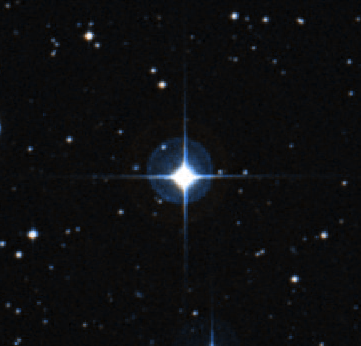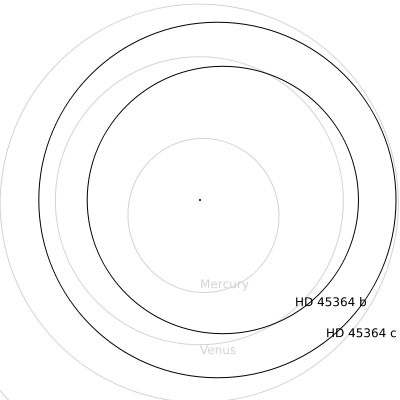
The picture shows the star HD45364 which is slightly smaller than our sun. There are also two planets orbiting this star. Unfortunately, they are not visible in the picture because they are too small and the star is too bright. But the planets make the star wobble as they go around it. We only know about the planets because of this reflex motion. One of the planets is similar to our Jupiter, the other has the same mass than our Saturn. The most striking fact is that the more massive planet is on the outside. The planets swapped places compared to our solar system, where Jupiter, the more massive one, is interior to Saturn. Furthermore, the planets are in a 3:2 resonance, meaning that one planet orbits the star exactly three times while the other one orbits the star twice. A plot of the orbits of both planets is shown below. Note that, because they are in a 3:2 resonance, their orbits are very close together but nevertheless stable. How could such a system form and why is it not like our own solar system?

To answer these question, we have performed two dimensional hydrodynamic simulations. We simulate the final stages of the planet formation process. The planets have already accumulated all their mass but are still embedded in the proto-planetary disc. This disc contains the material which all planets are made of. In that stage, the planets strongly interact with the proto-planetary disc. Due to the exchange of angular momentum, the planet can move within the disc. They usually spiral inwards on very long timescales. That is called planetary migration. In special circumstances they can also migrate inwards very quickly. In astronomical terms, quickly still means a few thousand years. But that is very short compared to the millions of years that the whole process of forming a planetary system takes.

The above plot shows a snapshot of a simulation with both planets orbiting the star HD45364. Clearly visible are the long spiral waves created by the planets. The darker, blueish region is a gap in the disc, opened by the Jupiter-mass planet. The planet is so massive, that it can shape the profile of the proto-stellar disc in its vicinity. The smaller planet, just inside of the gap is not massive enough to do that. It turns out that this difference, whether a planet can open a gap or not, is one key to explaining the formation of the whole system.
The goal of the study is to reproduce the observed 3:2 resonance. Resonances are a natural outcome of migrating planets. Whenever planets migrate at different speeds, and this happens almost all the time, they can end up in a resonance. There are many resonances, more precisely, there is an infinite number of resonances. Three important factors determine the final resonance of two migrating planets:
- The planets’ masses
- The initial positions of the planets
- The migration speed
The masses of the planets are well constrained from observations. It’s also not expected that they change during the migration phase. Varying the initial positions would allow us to get the wanted 3:2 resonance. But we can even try to think of a more generic formation scenario by assuming that one of the planets migrates very rapidly. This happens naturally in a massive disc. If the migration speed of the outer planets exceeds a certain value, then the end result is always the 3:2 resonance.
The conclusion from this study is quite interesting. To form the system’s orbital configuration, namely the 3:2 resonance, we assumed a fairly massive proto-planetary disc. This is the only requirement that is put in by hand. Everything else is computed self-consistently. We can even go further and make some predictions!

All our simulations produce a generic pattern of orbital parameters. It is different from what has been known from the observational data alone. Our results show that the eccentricities of both planets should be a factor 4-5 smaller. In other words, we predict that the orbits of the planets are much more circular. In the plot shown above, the two curves show the different solutions: The green one with the higher peaks is the one with large eccentricities; The blue one is the prediction that comes from our formation scenario with more circular orbits. The red points are measurements of the star’s wobbling. It can be seen from the plot that the current observational data is not good enough to choose a clear winner. However, only a few more data points have to be taken whenever the discrepancy between the two models is large. Hopefully, we can confirm the first predicted orbital configuration of an exo-planet within a couple of years!
More details can be found in our scientific article, which has been highlighted in a recent edition of Astronomy and Astrophysics. The article is also available free of charge from the arXiv servers.
